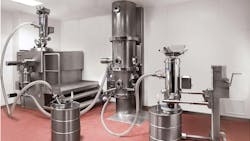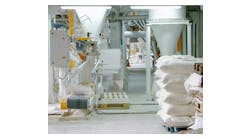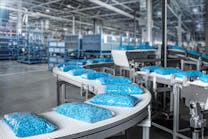Evaluating conveying equipment for changeover compatibility
Health and dietary trends come and go faster than ever. Whether it is no carbs, gluten-free, fat-free, healthy fats or replacing prescription pills with organic foods as medicine, American consumers seem eager to chase the next wellness idea regardless of FDA approvals or peer-reviewed data. This can be a boon for food, nutrition and pharmaceutical companies that offer the right product mix at the right time. But these trends are typically short-lived and may leave gleaming new processing capacity idle as each hot health craze is superseded by the next.
This is a key reason why processing versatility has overtaken sheer speed among the most important factors in process equipment purchasing. Versatility enables manufacturers to quickly capitalize on the next trend, adjusting flavor profiles, adding functional ingredients and shifting resources to new product R&D without investing in expanded facilities or dedicated, new equipment.
Versatility as a business strategy also relies on frequent product changeovers, with myriad adjustments to one or more machines and a complete cleaning inside and outside to prevent cross-contamination. Though many manufacturers claim that their equipment cleans easily, after installation when performing an actual changeover, end users often realize that this is not the case. However, a situation like this may represent a failure to effectively communicate definitions of clean rather than a nefarious plot by the supplier to sell equipment.
Defining clean
Every process manufacturer needs to achieve a given level of cleanliness based on its own definition of clean. Even two competing process manufacturers producing similar products can view cleanliness differently. The definition is typically a balance of factors, such as the types of products in process, federal and local regulations, and the severity of consequences in the event of an oversight. A contract food processor transferring nuts into a mixer, for example, needs to be especially careful about the risk of cross-contamination when switching from peanuts to almonds due to the potential allergen risk. However, the risk when switching from a coarse salt to a fine-grain salt are far less severe. Changeovers in a validated pharmaceutical process demand a higher level of cleanliness, with written protocols documenting how this extreme state of hygiene is to be achieved. The chemical makeup of a drug simply cannot be compromised by the residue of another active ingredient left in a hopper, conveyor or discharge chute. And frequent swab tests with laboratory analysis are often required to verify cleanliness.
These examples carry different levels of risk and, therefore, do not typically require the same level of cleanliness during changeovers. In fact, when cleaning between batches of the same or very similar products, equipment needs only to be “visibly clean” per the FDA, since there is little risk of cross-contamination. It is not uncommon for process manufacturers to target several different levels of cleanliness in the same plant or on the same production line depending on the products in process.
Defining inspectable
Regardless of the targeted level of cleanliness, the equipment needs to be inspectable to test and verify that the level has been achieved. The 3-A sanitary standards the USDA uses for dairy processing provide a much clearer definition of inspectable than other regulatory agencies provide. Inspectable means an item or area can be made available or exposed for close visual observation. Further, component parts are to be fully accessible for inspection or cleaning, demountable parts are to be readily demountable, there shall be no non-inspectable surfaces, and all manually cleaned product contact surfaces shall be easily accessible for inspection and cleaning without completely entering the vessel, which would create an OSHA confined space entry safety risk. When frequent changeovers become the standard and changeover speed becomes increasingly important, the USDA's keywords to focus on when evaluating different types of conveying systems are readily, easily and accessible.
Belt conveyors
On the surface, belt conveyors seem quite accessible. Workers commonly clean soiled belts, remove any carryback material and vacuum up spillage from the plant floor in between batches or when changing products. But cleaning and inspecting under the belt often presents a serious challenge, with a potentially long shutdown and tedious work for a skilled mechanic or maintenance person if removal is required. Any overlooked food residue can quickly develop infectious bacteria that affects subsequent material. These conveyors also invite contamination risk from contact with lubricants, pests, humidity and other factors due to their open exposure to the plant environment.
Flexible screw conveyors
Enclosed conveying systems reduce the risk of exposure to the plant environment but also block or reduce access to the interior for cleaning and inspection. Flexible screw conveyors, for example, set a screw auger inside an enclosed pipe. As the screw rotates, material moves from a hopper at the bottom to a discharge at the top. In a frequent changeover situation, a screw conveyor often becomes a hindrance to speed and efficiency because it is difficult to access the interior. The conveyor must be detached from the hopper and discharge end, the screw removed — often using a hoist — then each flight cleaned, and the pipe interior cleaned with a long brush. Because the disassembly and inspectability are not ready, easy or accessible, flexible screw conveyors are better for transferring powders in a process dedicated to a single product or material.
Bucket elevators
The engineering behind a bucket elevator is very similar to that of a screw conveyor, but instead of enclosing the material in a pipe, the material is transferred in individual buckets while exposed to the plant environment. This is not ideal for sanitary processing. Depending on the layout, accessing each individual bucket for cleaning and inspection is not difficult, but it is time-consuming, labor-intensive and subject to the same spillage cleanup and other contamination risks as with an open belt conveyor. Even in semi-automated and clean-in-place (CIP) environments, the cumbersome nature of a bucket elevator often makes disassembly, cleaning and inspection a significant project. Bucket elevators are typically specified to move large volumes of powder when the targeted definition of clean is easily achievable using basic approaches to hygiene.
Pneumatic vacuum conveyors
Pneumatic vacuum conveying systems operate in a fully enclosed process that safeguards against contamination from exposure. Typically featuring a vacuum pump or pressurized sending vessel to generate the transfer action, a pneumatic vacuum conveyor creates a sealed, dust-tight system that automatically conveys powders, pellets and other bulk materials through hoses or piping from storage directly into a mixer, reactor or other vessel without worker involvement. Downstream, these air conveying systems can also be used to capture finished products, such as tablets from a tablet press or a mixture of dried fruits and nuts and convey them directly to storage or to filling and packaging.
With the ability to capture material from an open drum, bulk bag unloading station or silo, the same conveying system may be used to transfer different materials from various sources into a process multiple times per day, every day. This versatility also means that the system may need to be cleaned and inspected multiple times per day, every day, depending on the required standard of cleanliness.
Each connection linking the conveying hose to a feeder, discharge chute or other equipment may need to be disconnected, cleaned and returned to service. The vacuum pump may need to be disassembled to access and clean the internal air filter to prevent entrained fine powders from contaminating the next material. Hoses may need to be disconnected, cleaned, dried and returned to service.
But pneumatic conveying systems are not all created equal. The Volkmann Multijector vacuum pump, for example, earned a patent for easy access to the filter system without any tools for complete disassembly, filter replacement and cleaning either by hand or through a parts washer in less than 10 minutes. In fact, since an entry level worker can easily manage this part of the changeover process with minimal downtime, many companies that install these systems increase the frequency of product changeovers beyond the level anticipated because the headache factor and risk of cross-contamination have been virtually eliminated.
At a time when process manufacturers need to produce multiple products on the same process equipment with varying levels of staffing support, cleanability for frequent changeovers must be considered a vital asset in a conveying system. Speed of disassembly, ease of cleaning and access for inspection and verification are key factors.
David Nichols is vice president of sales and marketing for Volkmann USA. The company designs and manufactures ATEX-certified pneumatic vacuum conveying systems and other powder processing equipment and presents ATEX safety seminars for processors operating in explosive environments.
Volkmann USA



